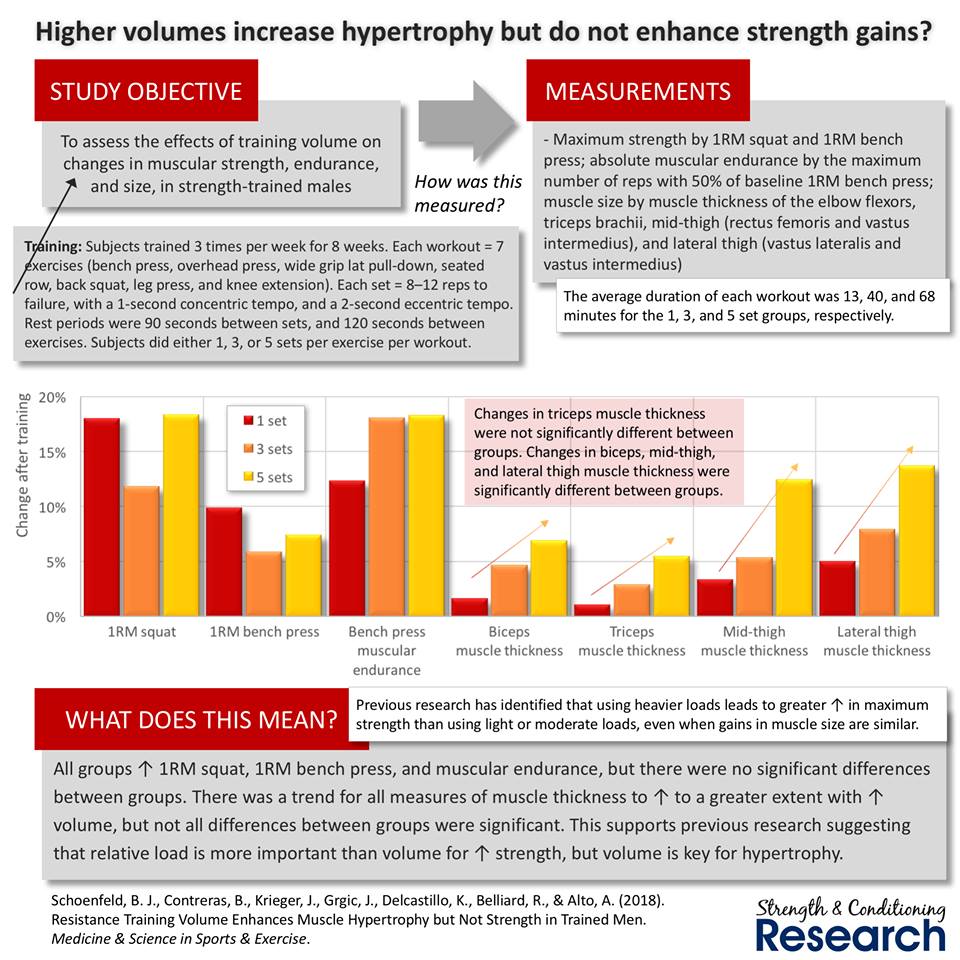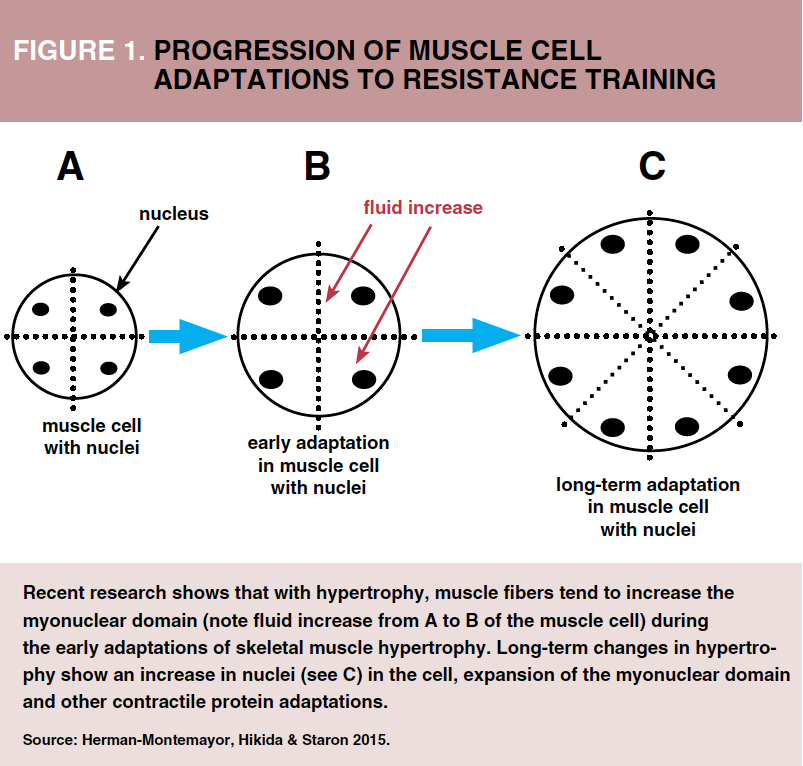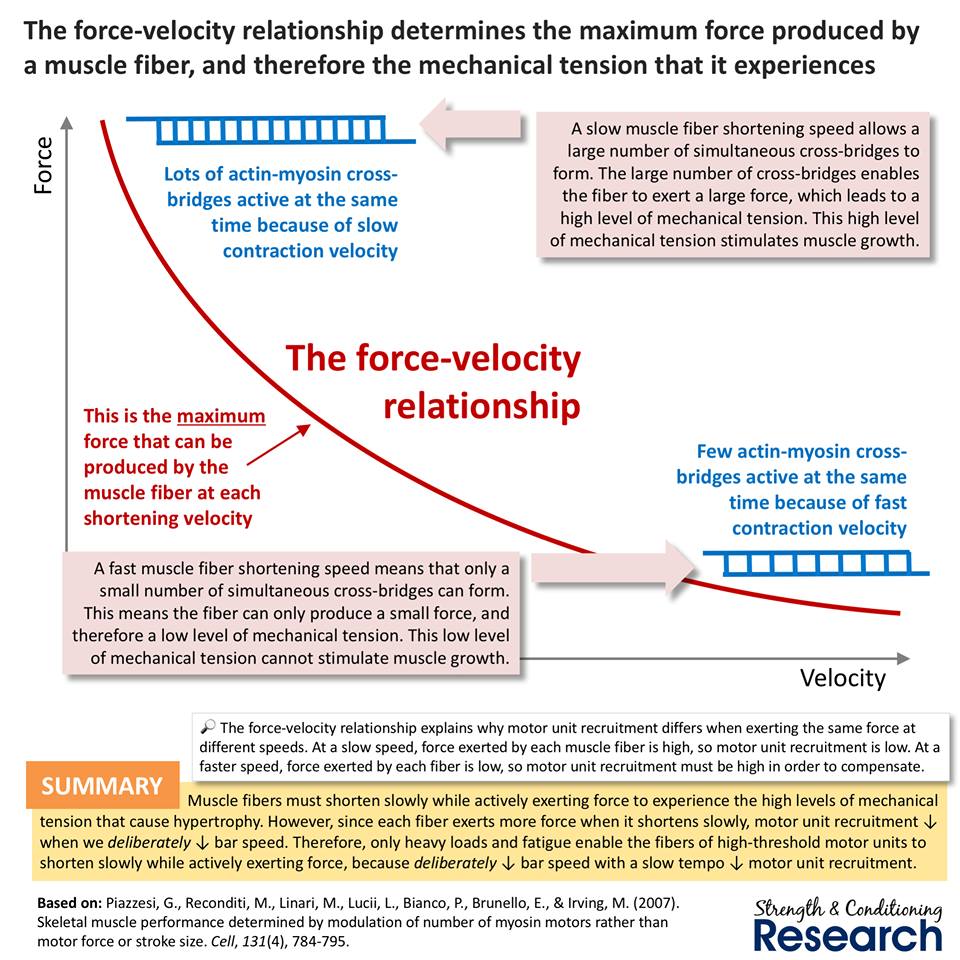You are using an out of date browser. It may not display this or other websites correctly.
You should upgrade or use an alternative browser.
You should upgrade or use an alternative browser.
More Support For Myo And Effective Reps
- Thread starter Old and Grey
- Start date
Ah now that is fascinating... I wonder what velocity specifically they're referring to (if it can be measured).. so essentially slower velocity reps (fibers shortening at a slower rate) allow a larger number of cross-bridges to form and therefore more force exerted, thus higher mechanical tension... and vice versa? Interesting!
k_dean_curtis
Member
IIRC, max speed to see optimum cross bridges was 2 seconds for a normal ROM exercise. After 4 or 5 seconds the results dropped off. So a cadence of 2 up, 2 or 3 down is about right.
Here's some more support in interesting study, I have not seen mentioned, with the caveat it's with untrained folks:
"Our unique training protocol resulted in a superior increase in muscle growth in comparison with most other strength training studies. Our result can be converted to an increase of 17,3 % (0,25 % per day) in VL muscle CSA, which is much greater than the mean increase of 0,11 % per day reported in a large meta-analysis (Wernbom, Augustsson & Thomeé 2007) "
(PDF) Optimizing strength training for.... Available from: https://www.researchgate.net/public..._training_and_blood-flow_restriction_training
The 2016 paper looks like a setup to what someone may do based on Borge's Reignite article (late 2014, I think).
"Our unique training protocol resulted in a superior increase in muscle growth in comparison with most other strength training studies. Our result can be converted to an increase of 17,3 % (0,25 % per day) in VL muscle CSA, which is much greater than the mean increase of 0,11 % per day reported in a large meta-analysis (Wernbom, Augustsson & Thomeé 2007) "
(PDF) Optimizing strength training for.... Available from: https://www.researchgate.net/public..._training_and_blood-flow_restriction_training
The 2016 paper looks like a setup to what someone may do based on Borge's Reignite article (late 2014, I think).
A lot of people are jumping on Blade's bandwagon without giving him the credit due. Charles Staley was the latest one in T Nation.
I have no problems with that, as long as it is furthering our collective understanding of how we can get stronger and make a muscle grow. What I have a problem with are the current debates and arguments where people are getting all riled up because some new study apparently should make us forget everything that has been done for the last 5-7 decades (e.g. Schoenfeld’s recent volume study).
This one? 


Yeah, and I think Lyle did a great review on it here:
https://bodyrecomposition.com/resea...nces-muscle-hypertrophy-research-review.html/
https://bodyrecomposition.com/resea...nces-muscle-hypertrophy-research-review.html/
NWlifter
Active Member
I did find something interesting on the 'strength size' part of that though...
I'll summarize, then post the study and another graphic I found where the study was being discussed.
There does seem to be ‘some’ sarcoplasmic hypertrophy (as in, more cytoplasm without myofibrilliar size increases), apparently, this can happen first, for a while, then once the domain is maxed, THEN nuclei are added and actual contractile increases occur. The higher volume may have increased cytoplasm much more with equal strength gains, later, if able, the subjects would have then increased myo-nuclei numbers and fibril hypertrophy would occur and THAT would lead to a strength increase. This is not to be confused with swelling or fluid changes, which may or may not also accompany resistance training. This is intra-cellular cytoplasm increases (aka sarcoplasmic hypertrophy) This cannot continue long term without myo-nuclei additions and concurrent fibril hypertrophy, but seems it can be predominant even up to 3 months. It appears to be a ‘stair step’ phenomena as described below. Higher ratio of cytoplasm, leads to additional nuclei, fibril hypertrophy ‘catches up’, then cytoplasm increase, then fibril, etc.
https://journals.lww.com/.../Early_Phase_Satellite_Cell...
Below a couple quotes from the study
Myonuclear domain is the volume of cytoplasm within the multinucleated skeletal muscle fiber
In contrast, Kadi et al. reported a 17% increase in fiber cross-sectional area (CSA) of the quadriceps muscle group of young men after 3 months of resistance training, with a significant increase in MND and no change in myonuclear number (17).
Based on studies such as these, a “ceiling” for MND has been proposed, above which the addition of more myonuclei is required (17). Existing myonuclei are not usually operating at maximal capacity at baseline and have the ability to increase protein synthesis and cytoplasmic volume up to some threshold (17). O'Connor et al. have suggested that muscle hypertrophy consists of several phases in which early upregulation of transcription and translation in existing myonuclei is then followed by SC activation, proliferation, and potential incorporation (29).

I'll summarize, then post the study and another graphic I found where the study was being discussed.
There does seem to be ‘some’ sarcoplasmic hypertrophy (as in, more cytoplasm without myofibrilliar size increases), apparently, this can happen first, for a while, then once the domain is maxed, THEN nuclei are added and actual contractile increases occur. The higher volume may have increased cytoplasm much more with equal strength gains, later, if able, the subjects would have then increased myo-nuclei numbers and fibril hypertrophy would occur and THAT would lead to a strength increase. This is not to be confused with swelling or fluid changes, which may or may not also accompany resistance training. This is intra-cellular cytoplasm increases (aka sarcoplasmic hypertrophy) This cannot continue long term without myo-nuclei additions and concurrent fibril hypertrophy, but seems it can be predominant even up to 3 months. It appears to be a ‘stair step’ phenomena as described below. Higher ratio of cytoplasm, leads to additional nuclei, fibril hypertrophy ‘catches up’, then cytoplasm increase, then fibril, etc.
https://journals.lww.com/.../Early_Phase_Satellite_Cell...
Below a couple quotes from the study
Myonuclear domain is the volume of cytoplasm within the multinucleated skeletal muscle fiber
In contrast, Kadi et al. reported a 17% increase in fiber cross-sectional area (CSA) of the quadriceps muscle group of young men after 3 months of resistance training, with a significant increase in MND and no change in myonuclear number (17).
Based on studies such as these, a “ceiling” for MND has been proposed, above which the addition of more myonuclei is required (17). Existing myonuclei are not usually operating at maximal capacity at baseline and have the ability to increase protein synthesis and cytoplasmic volume up to some threshold (17). O'Connor et al. have suggested that muscle hypertrophy consists of several phases in which early upregulation of transcription and translation in existing myonuclei is then followed by SC activation, proliferation, and potential incorporation (29).

NWlifter
Active Member
Found this too...
IMO, the mystery of sarcoplasmic hypertrophy is solved. It's not 'yes' (as in one can bloat up huge with just that), but it's also not 'no' (as in sarco and myo are always proportional).
Description not title of study
Variations in post exercise protein synthesis, based on methods,
Sarcoplasmic PS vs Myofibrilliar PS
https://academic.oup.com/biomedgerontology/article/70/8/1024/2947660
Summation
RE (low volume heavy, approx 60 reps) : RE completed three sets of leg extension and leg press at loads equal to ~95% of their predetermined 10RM. The last set of each exercise was completed to failure.
HIIT (higher volume approx 450 'reps': 10 × 1 minute intervals on a bicycle ergometer cycling at a workload that was determined during familiarization to elicit ~95% HRmax (~90% V.O2peak). Participants maintained a cadence of at least 90rpm during these intervals.
Results
Myofibrillar protein fractional synthetic rate was elevated, relative to rest, at 24 and 48 hours following RE and HIIT. The increase in myofibrillar fractional synthetic rate was greater following RE versus HIIT at both time points. HIIT was the only mode of exercise to increase sarcoplasmic protein fractional synthetic rate 24-hour postexercise (2.30±0.34% d−1 vs 1.83±0.21% d−1).
Note: Heavy less volume = higher fibrilliar, very little sarcoplasmic PS. Higher volume = less fibrilliar, more sarcoplasmic PS.
So there 'is' a variance in the fractions post exercise based on method and volume 'seems' to be a factor.
IMO, the mystery of sarcoplasmic hypertrophy is solved. It's not 'yes' (as in one can bloat up huge with just that), but it's also not 'no' (as in sarco and myo are always proportional).
Description not title of study
Variations in post exercise protein synthesis, based on methods,
Sarcoplasmic PS vs Myofibrilliar PS
https://academic.oup.com/biomedgerontology/article/70/8/1024/2947660
Summation
RE (low volume heavy, approx 60 reps) : RE completed three sets of leg extension and leg press at loads equal to ~95% of their predetermined 10RM. The last set of each exercise was completed to failure.
HIIT (higher volume approx 450 'reps': 10 × 1 minute intervals on a bicycle ergometer cycling at a workload that was determined during familiarization to elicit ~95% HRmax (~90% V.O2peak). Participants maintained a cadence of at least 90rpm during these intervals.
Results
Myofibrillar protein fractional synthetic rate was elevated, relative to rest, at 24 and 48 hours following RE and HIIT. The increase in myofibrillar fractional synthetic rate was greater following RE versus HIIT at both time points. HIIT was the only mode of exercise to increase sarcoplasmic protein fractional synthetic rate 24-hour postexercise (2.30±0.34% d−1 vs 1.83±0.21% d−1).
Note: Heavy less volume = higher fibrilliar, very little sarcoplasmic PS. Higher volume = less fibrilliar, more sarcoplasmic PS.
So there 'is' a variance in the fractions post exercise based on method and volume 'seems' to be a factor.
Trainee/subjects were trained or not?
Direct from the study:
"Sedentary men (n = 22; 67±4 years; body mass index: 27.0±2.6 kg m−2 [mean ± SEM])"
NWlifter
Active Member
Yes, not sure though if trained or not matters on fractional PS, I've seen other ones where there were variances in the PS of sarco vs myo, what they purpose is interesting, as the MD increases, it hits a point where then donation is needed. It's possible higher volume increases fluids at a higher 'ratio' to make room for energy and related organelles, then later, that expansion triggers donation which increases nuclei , then higher fibril numbers. Not saying it's 'right' but it's a logical sounding idea.
Direct from the study:
"Sedentary men (n = 22; 67±4 years; body mass index: 27.0±2.6 kg m−2 [mean ± SEM])"
Well I would take sedentary to be different than untrained, but assuming they’re used interchangeably...then I’m not sure it’s worth anything.
Just throwing a 2.5kg plate at an untrained subject and hitting them with a good win is going to elicit a response.
Separately;
I tend to agree that sarcoplasm expansion feeds into myonuclei donation - i.e. you need more bosses as the worker count increases.
The copied ‘Figure 1’ above is missing a step, IMO. Largest circle with only 4 nuclei. Or similar.
Yes, the could have put one more circle in there.
yeah, who knows on all this, at least this shows a mechanism and actual measured sarco increases in humans, kinda cool.
Not sure if you follow any of the current podcasts, but a number of commentators have remarked that they see myonuclei donation as being associated with sarcoplasm expansion.
Obviously there must be something else to it, or BFR would be more effective and permanent in its impact.

